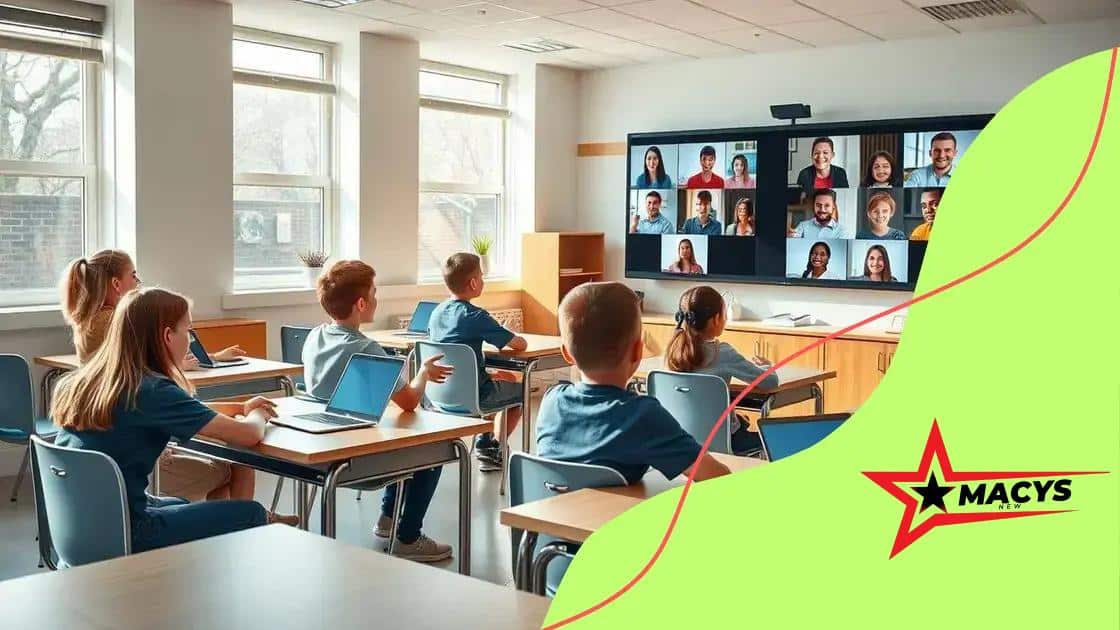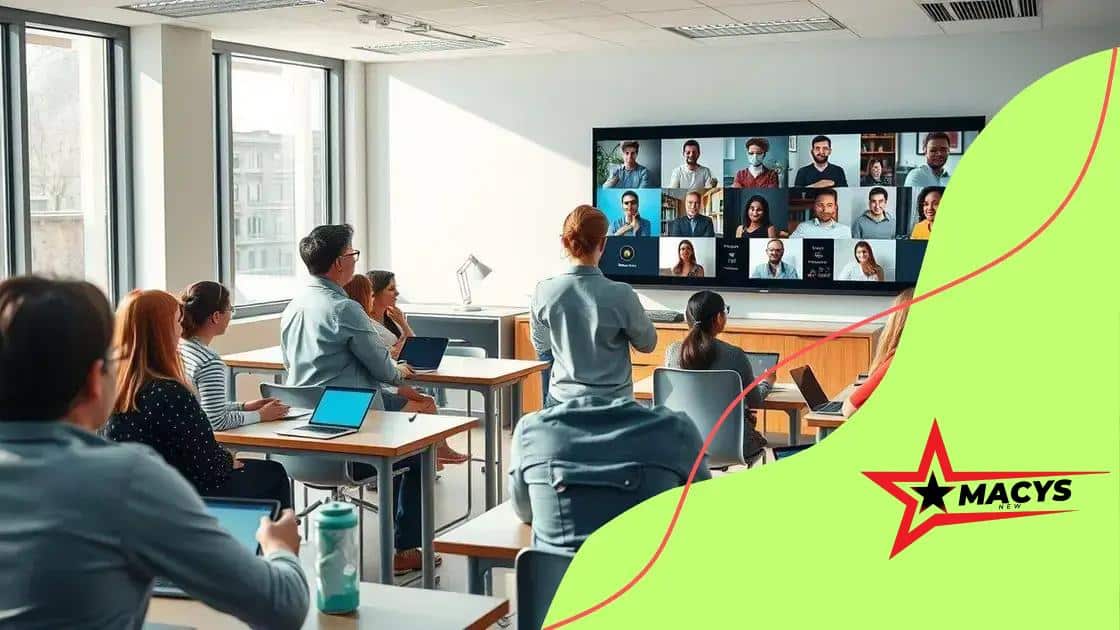Hybrid learning models in higher education: exploring benefits

Hybrid learning models in higher education combine traditional classroom instruction with online learning, offering flexibility, increased accessibility, and enhanced student engagement while addressing diverse learning needs.
Hybrid learning models in higher education are transforming how students engage with content and interact with instructors. Have you considered how this approach might enhance your educational experience? Let’s delve into its advantages and potential challenges.
Understanding hybrid learning models
Understanding hybrid learning models is essential for grasping the future of education. These models combine traditional classroom experiences with online learning to create engaging educational environments.
One key aspect of hybrid learning is its flexibility. Students can attend classes in person while also participating online. This dual approach helps meet diverse learning needs.
The Different Types of Hybrid Learning Models
There are various types of hybrid learning models, each designed to cater to different educational needs. Some popular models include:
- Blended Learning: This approach mixes in-person and digital learning activities.
- Ala Carte Model: Students choose from options, taking some courses in person and some online.
- Self-Directed Learning: Students learn at their own pace using online resources alongside scheduled classes.
Teachers play a vital role in making hybrid learning successful. They must adapt teaching strategies to facilitate online engagement. This can be done through interactive tools that captivate students’ attention.
Benefits of Hybrid Learning Models
One of the main benefits is the increased accessibility to education. Students can learn from anywhere, making it easier for those with commitments to balance their education. Furthermore, hybrid models often enhance collaboration among peers, fostering a sense of community even in digital spaces.
However, hybrid learning is not without challenges. Educators must be prepared to support students through technical issues and ensure that all learners have equal access to resources. With proper training and support, these challenges can be navigated effectively.
In summary, understanding hybrid learning models allows us to appreciate the evolving landscape of education. As we continue to adapt, integrating these models will play a key role in shaping the future of learning.
Key benefits of hybrid learning in education
Exploring the key benefits of hybrid learning in education reveals how this approach can transform traditional educational practices. It combines the best of both online and in-person learning, offering a unique blend that enhances the learning experience.
One of the most significant advantages is the flexibility it offers. Students can attend classes from anywhere, allowing for a more personalized learning environment. This flexibility is vital for students who have jobs or other commitments.
Increased Accessibility
Hybrid learning makes education more accessible.
- Students can participate from remote locations.
- It removes barriers like transportation and scheduling conflicts.
- Online resources are available anytime, allowing for self-paced learning.
Another advantage is the potential for enhanced engagement. Hybrid models use technology to create interactive learning experiences. Students can participate in real-time discussions, access multimedia resources, and collaborate with peers effectively.
Fostering Collaboration
Collaboration is at the heart of effective learning.
- Hybrid environments enable group projects across distances.
- Students can share ideas and feedback through digital platforms.
- Instructors can facilitate discussions that include both in-person and online learners.
Additionally, hybrid learning promotes skill development. Students learn to navigate digital tools, which prepares them for modern workplaces. They also develop time management skills as they balance in-person and online components.
In sum, the key benefits of hybrid learning in education include increased accessibility, enhanced engagement, and valuable skill development. This innovative approach to learning equips students for future success.
Challenges of implementing hybrid learning

Implementing hybrid learning comes with its own set of challenges. While this model offers many benefits, understanding the difficulties can help educators and institutions make necessary adjustments.
One major challenge is ensuring technology access. Not all students have reliable internet or devices. This gap can hinder their ability to participate fully in hybrid courses.
Technical Issues
Another problem often faced is technical difficulties during live sessions. These can include issues such as:
- Connection drops that interrupt learning.
- Incompatibility with student devices.
- Technical glitches with the online learning platform.
Educators must be adept at troubleshooting these issues quickly. They should also be prepared to offer support to students who encounter technical barriers.
Maintaining Engagement
Engagement can suffer in a hybrid environment. When some students are in the classroom and others are online, it’s challenging to keep everyone involved. Teachers need to employ diverse strategies to keep all students focused and active. This often requires creative lesson planning and the use of interactive tools.
Another challenge lies in ensuring equity in participation. It’s vital that all students, regardless of their learning mode, receive equal attention and support. This may require additional training for teachers to foster an inclusive environment.
Overall, understanding the challenges of implementing hybrid learning can help schools navigate this innovative model more effectively. By addressing these issues head-on, institutions can enhance the learning experience for all students.
Best practices for hybrid learning strategies
Implementing best practices for hybrid learning strategies is crucial for maximizing the effectiveness of this educational approach. By combining online and in-person methods, educators can create a more engaging and flexible learning environment.
One effective strategy is to use technology that enhances interaction. Tools such as video conferencing, discussion boards, and collaborative platforms can bridge the gap between remote and in-person students. This allows for effective discussions and group activities.
Clear Communication
Maintaining clear communication with students is essential. Informing them about schedules, expectations, and how to access resources fosters a supportive learning atmosphere. Instructors can use:
- Email updates for important announcements.
- Dedicated online spaces for questions and feedback.
- Synchronous check-ins to ensure everyone is engaged.
Additionally, providing flexible learning options can cater to different student needs. Some may prefer attending classes in person, while others thrive in a completely online setting. Offering resources and assignments in various formats helps accommodate diverse learning preferences.
Active Learning Techniques
Incorporating active learning techniques is another best practice. Use group projects, hands-on activities, and interactive discussions to keep students engaged, both online and offline. This approach not only makes learning more enjoyable but also reinforces critical thinking skills.
Finally, collecting feedback regularly is vital for adjusting hybrid strategies. By understanding what works and what doesn’t, educators can refine their methods. Surveys, polls, and informal check-ins can help gauge student satisfaction and improve overall experiences.
In summary, applying these best practices for hybrid learning strategies can greatly enhance student engagement and learning outcomes, paving the way for successful education in a hybrid environment.
Case studies of successful hybrid learning
Examining case studies of successful hybrid learning can provide valuable insights into how this educational model can be effectively implemented. These examples highlight innovative approaches and effective strategies that have enhanced the learning experience.
One notable case is the implementation at a major university where instructors used blended learning techniques. Professors combined in-person lectures with online modules that students could access anytime. This format allowed students to engage with course material at their own pace while still benefiting from live discussions.
Successful Examples from High Schools
Another interesting case comes from a high school that adopted hybrid learning to address varying student needs. This school developed a model that allowed students to choose between attending classes in person or participating online. The outcomes included:
- Improved student attendance rates.
- Higher engagement levels, particularly among students who struggled in traditional settings.
- Enhanced use of technology in the classroom, fostering digital literacy.
Additionally, a community college implemented a hybrid program designed for adult learners. This program focused on career skills and involved a mix of online tutorials and hands-on workshops. Students reported feeling more prepared for the workforce, thanks to the practical experience combined with flexible learning options.
Benefits Across Various Fields
Case studies from various disciplines, such as healthcare and business, also showcase the effectiveness of hybrid learning. In healthcare training, for example, students engaged in online simulations followed by in-person clinical placement. This method provided essential theoretical knowledge while allowing students to apply skills in real-world situations.
Moreover, small business courses utilizing hybrid learning techniques reported a significant increase in student satisfaction. By blending lectures with online discussions and group projects, students felt more connected and engaged.
In summary, these case studies of successful hybrid learning illustrate how different institutions have adapted this model to enhance education. By adopting best practices and adapting to their unique needs, schools and universities can offer effective and engaging learning experiences.
In conclusion, hybrid learning models are shaping the future of education by combining traditional and online methods. They provide increased flexibility, engagement, and accessibility for students. By learning from successful case studies and implementing best practices, educational institutions can adapt to the changing landscape and meet the diverse needs of all learners. As technology continues to evolve, the potential for hybrid learning will only grow, making it an exciting time for education.
\n\n
| Topic | Details |
|---|---|
| Flexibility 🌍 | Hybrid models allow students to learn anytime, anywhere. |
| Engagement 🎓 | Interactive tools enhance student participation. |
| Accessibility 🖥️ | Easier access for students with varying needs. |
| Best Practices ✅ | Using diverse strategies to keep students engaged. |
| Success Stories 📚 | Learning from case studies helps improve strategies. |
\n
FAQ – Frequently Asked Questions about Hybrid Learning Models
What is hybrid learning?
Hybrid learning is an educational approach that combines traditional in-person instruction with online learning, allowing for more flexibility and accessibility.
What are the benefits of hybrid learning?
Benefits of hybrid learning include increased flexibility for students, enhanced engagement through interactive tools, and the ability to cater to diverse learning needs.
How can instructors ensure effective communication in hybrid learning?
Instructors can ensure effective communication by providing regular updates, utilizing online platforms for interaction, and maintaining open channels for feedback.
What challenges might institutions face when implementing hybrid learning?
Challenges can include ensuring technology access for all students, maintaining engagement levels across different learning modes, and addressing technical issues during live sessions.





